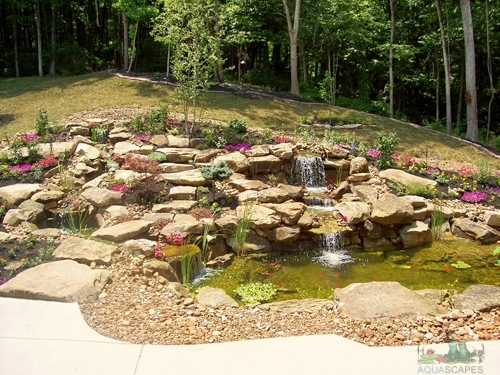Installing a Backyard Pond in 2025
When it comes to installing a backyard pond, there are many options. Creating a backyard pond can be a transformative project for any homeowner. It adds a visually striking element to your garden and creates a tranquil space for relaxation, attracts wildlife, and can even increase property value. This quick outline will walk you through installing a backyard pond, from planning and design to installation and maintenance. We are located in Cincinnati, Ohio and have created many happy customers. Please feel free to reach out to us so we can service you if you are in the tri-state area, such as Northern Kentucky and Indiana. If you’re within the 275 loop in Cincinnati, we’re right around the corner!
Planning Your Pond
1. Determine the Purpose: Before you dig, decide what the primary purpose of your pond will be. Is it for koi, water gardening, a wildlife habitat, or purely aesthetic? This decision will influence the size, depth, and location of your pond.
2. Choose the Right Location: Select a spot that gets 4-6 hours of sunlight per day, which is ideal for aquatic plants. Avoid areas under trees to minimize leaf debris and avoid areas with heavy root systems that could complicate digging. Ensure the site is away from utility lines.
3. Size and Depth Considerations: The size of your pond depends on what you want to achieve. A small pond is typically 2-3 feet deep and can host small fish and modest plant life. Larger ponds, which are better for fish like koi, need to be at least 3 feet deep to provide a safe haven from predators and harsh weather.
Designing Your Pond
1. Shape and Style: Ponds can be free-formed or geometric depending on the aesthetic you want to achieve. Natural-looking ponds often integrate seamlessly into the landscape, while formal ponds can act as a focal point.
2. Adding Features: Consider incorporating waterfalls, fountains, or streams for visual interest and to improve water circulation and oxygenation. Plan these features early as they will impact the construction process.
3. Selecting Materials: For lining your pond, you can choose between flexible liners, preformed liners, or concrete. Flexible liners offer more shape customization while preformed liners are easier to install but limited in shapes and sizes.
Installation Process
1. Excavation: Mark out the area for your pond using a hose or rope and begin excavating with a spade or a small excavator for larger projects. Remove all debris and rocks and level the area as you dig.
2. Install the Liner: Place a layer of sand or underlayment to protect the liner from punctures. Lay the liner over the hole, making sure it fits snugly into all corners and edges. Secure the edges with heavy stones or landscape pegs.
3. Fill the Pond: Start filling the pond with water. As it fills, adjust the liner to ensure it sits evenly against the contours of the pond. Trim any excess liner, leaving enough around the edges to secure it properly.
4. Install Equipment: Set up your filtration system, pumps, and any other mechanical systems necessary to maintain water quality and circulation. Position electrical outlets far from the water and ensure all wiring complies with local codes.
Installing a Backyard Pond – Landscaping and Planting
1. Edging Your Pond: Use natural stones, pavers, or plants to create a beautiful and natural transition from the pond to the rest of your garden. This also helps to conceal the liner.
2. Choosing Plants: Select a mix of submerged, marginal, and floating plants. This not only adds to the beauty of the pond but also contributes to the ecological balance, helping to keep the water clean and oxygenated.
3. Introducing Fish: If you plan on adding fish like koi or goldfish, ensure your pond is deep enough and has the proper biological balance. Acclimate your fish to the pond environment gradually to reduce stress.
Maintenance after installing a backyard pond
1. Regular Cleaning: Keep the pond clear of debris with a net and vacuum the bottom to remove sludge that accumulates.
2. Water Quality Management: Regularly check and adjust the pH and nutrient levels in the pond to prevent algae growth. Replace a portion of the pond water periodically to maintain freshness.
3. Seasonal Care: Prepare your pond for winter by removing sensitive plants and installing a pond heater or aerator to keep the surface from completely freezing.
Installing a backyard pond in 2025 is a rewarding endeavor that enhances your outdoor living space and provides a habitat for wildlife. With careful planning, the right materials, and ongoing maintenance, your pond will thrive for years to come, bringing beauty and tranquility to your garden. Whether you’re a seasoned gardener or a DIY enthusiast, a backyard pond is a project that can bring immense satisfaction and enjoyment.

